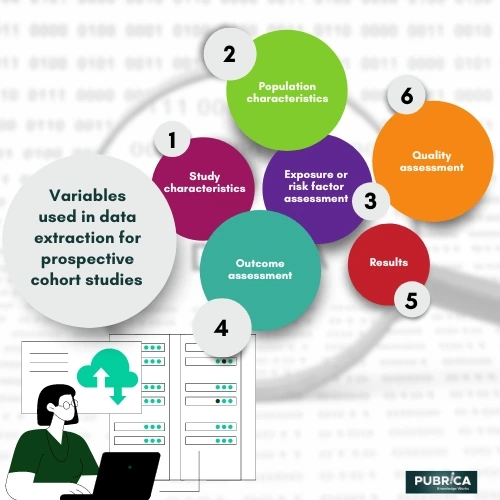
Ten Basic Guidelines for Conducting and Publishing a Meta-analysis
August 4, 2023
Guidelines for Addressing to Reviewers’ Comments
August 21, 2023Variables Used in Data Extraction for Prospective Cohort Studies in a Systematic Review
Variables Used in Data Extraction for Prospective Cohort Studies in a Systematic Review
Data extraction is an important stage in systematic reviews because it captures critical study features in an organized and consistent format. It is required for analyzing bias risk and synthesizing results. Interventional, diagnostic, and prognostic reviews take data from predetermined fields such as population, intervention, comparison, and results. Data extraction by hand can be time-consuming and repetitive, but intelligent software allows for automatic identification and medical data collection. This semi-automation integrates with EBM and data science, and interest in its research is expanding alongside AI in other computer science domains.
A data-extraction form based on crucial factors to prognosis to analyze the features of reviews and primary research was designed and is accessible on request from the first author. Before the form was finished, it was pilot-tested by all review writers, and small changes were made following a discussion of the disparities in scores. One narrative review author rated all reviews, while others scored all reviews collectively. Consensus sessions were convened within two weeks of the review’s completion to resolve differences. A third reviewer was consulted to make the ultimate judgment if an agreement could not be achieved.
An item was rated ‘yes’ if positive information on that specific methodological item was discovered, for example, if it was obvious that sensitivity analyses were performed. If it was evident that a certain methodological condition was not met, a ‘no’ was assigned; for example, no sensitivity analyses were performed. ‘Unclear’ was scored when there was a question or uncertainty. A methodological item may be graded as ‘not applicable’ at times. The proportion and quantity of reviews within each answer category were given.
- To know more about Medical Data collection Services, check our study guide. What are examples of medical survey data collection?
What is a data extraction tool in research?
A data extraction tool in research is a software or systematic approach designed to gather relevant information from various sources, such as research papers, databases, or surveys. This tool streamlines the process by automating the extraction of specific data points, such as variables, outcomes, sample sizes, and methodologies. It ensures consistency, reduces manual effort, and enhances the efficiency of systematic literature reviews, meta-analyses, or any research requiring data synthesis. By facilitating the organization and categorization of data, these tools enable researchers to analyze, compare, and draw meaningful insights from a large volume of information, ultimately contributing to robust and evidence-based conclusions.
When conducting a systematic review of prospective cohort studies, it’s crucial to extract relevant data from the included studies in a consistent and structured manner. Here are some variables to consider when creating a data extraction form for your systematic review:
- Study characteristics: a) Study title b) Authors c) Publication year d) Journal e) Study location (country, region) f) Study design (e.g., prospective cohort) g) Funding sources
- Population characteristics: a) Sample size b) Age range or mean age c) Sex distribution d) Ethnicity e) Baseline health status (e.g., healthy, presence of specific conditions) f) Inclusion and exclusion criteria
- Exposure or risk factor assessment: a) Definition of exposure or risk factor b) Measurement method (e.g., questionnaire, biomarker) c) Exposure categories or levels d) Frequency or duration of exposure e) Confounding factors considered or adjusted for
- Outcome assessment: a) Definition of the outcome(s) of interest b) Measurement method (e.g., self-report, medical records, death certificates) c) Duration of follow-up d) Incidence or prevalence of the outcome(s) in exposed and non-exposed groups e) Loss to follow-up or attrition rate
- Results: a) Crude and adjusted effect estimates (e.g., hazard ratios, odds ratios, risk ratios) b) Confidence intervals or standard errors c) Statistical significance (e.g., p-values) d) Subgroup analyses or effect modification, if applicable
- Quality assessment: a) Newcastle-Ottawa Scale (NOS) score or another quality assessment tool b) Risk of bias assessment, if applicable

This list is not exhaustive and can be tailored to your specific research question and the scope of your Prisma systematic review. By extracting these variables consistently across all included prospective cohort studies, you can effectively compare and synthesize their findings and draw robust conclusions.
- Check our Medical data collectionsample work to know and learn more about, Medical data collection on interstitial cysts and drug uracyst’s impact on patient quality of life.
Conclusion
In conclusion, the variables utilized in data extraction for prospective cohort studies play a pivotal role in ensuring the quality and comprehensiveness of systematic reviews. These variables include participant characteristics, exposure factors, outcome measures, follow-up durations, and methodological details. Thorough and standardized extraction of these variables enhances the reliability and comparability of findings across studies. It allows researchers to identify trends, assess risk factors, and draw meaningful conclusions. Rigorous attention to selecting and harmonizing these variables is essential to the integrity of systematic reviews, empowering evidence-based decision-making and advancing our understanding of complex health and social phenomena.
About Pubrica
At Pubrica, we collect data from a wide range of sources and perform semantic annotation based on the research questions that you wanted to solve. Pubrica has the vast majority of the data in doctor’s notes; electronic medical records, prescriptions, and similar information are available. Although therein lies the golden possibility of big data in medical care, it’s challenging to yield valuable insights due to complex, unstructured, longitudinal, and voluminous data.
References
- Louie, Jimmy Chun Yu, et al. “Dairy consumption and overweight and obesity: a systematic review of prospective cohort studies.” Obesity Reviews 12.7 (2011): e582-e592. https://doi.org/10.1111/j.1467-789X.2011.00881.x
- Schmidt L, Olorisade BK, McGuinness LA, Thomas J, Higgins JPT. Data extraction methods for systematic review (semi)automation: A living systematic review. F1000Res. 2021 May 19;10:401. doi: 10.12688/f1000research.51117.1. PMID: 34408850; PMCID: PMC8361807

14 years of expertise in clinical research with a doctoral distinction in life science.


